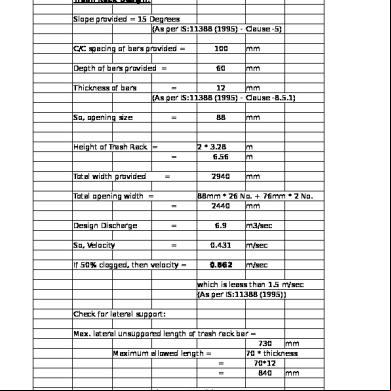Explain The Basic Features Of Income And Expenditure And Of Receipt And Payment t436v
This document was ed by and they confirmed that they have the permission to share it. If you are author or own the copyright of this book, please report to us by using this report form. Report 3b7i
Overview 3e4r5l
& View Explain The Basic Features Of Income And Expenditure And Of Receipt And Payment as PDF for free.
More details w3441
- Words: 697
- Pages: 2
Explain the basic features of Income and Expenditure and of Receipt and Payment Income and Expenditure (I&E) is a Nominal and is prepared on the accrual basis. It records all transactions of revenue nature that are related to the current ing period (whether outstanding or prepaid) for which the books are maintained. All expenses and losses are recorded on the debit side (Expenditure side) and all income and gains are recorded on the credit side (Income side) of I&E . The closing balance or the balancing figure of I&E is termed as surplus (or deficit), if the sum total of the Income side exceeds (is lesser than) the sum total of the Expenditure side. The following are the basic features of Income and Expenditure 1. Nature: It is a Nominal . The debit side of I&E records all expenses and losses and the credit side records all incomes and gains related to the current ing period. 2. Basis: It is prepared on the basis of Receipt and Payment (R&P). All the revenues items whether incomes or expenditures are transferred from R&P. 3. Excludes Capital Transactions: The transactions those are capital in nature are excluded from this . For example, only profit or loss on sale of fixed assets is recorded but the total amount of sales is not recorded since sale of fixed asset is considered as a capital receipt. 4. Akin to Profit and Loss : Income and Expenditure (I&E) is similar to the Profit and Loss in the sense that while the former is prepared to ascertain surplus or deficit during an ing period the latter is prepared to ascertain net profit or net loss incurred during an ing period. 5. Records only Current Year’s items: This records only those transactions that are related to current ing year. In other words, transactions related to the preceding or succeeding ing period are excluded even if these transactions are realised in the current period. 6. Adjustments: Various cash and non-cash items like, outstanding expenses, prepaid expenses, income received in advance, income due but not received, depreciation, bad debts, etc. can be adjusted in this . 7. Balancing Figure: The balancing figure of this is expressed in of either surplus (if incomes > expenses) or deficit (if expenses > incomes). The surplus balance, if any, is added to the Capital Fund, whereas, the deficit balance, if any, is deducted from the Capital Fund. Receipts and Payments is a summary of the Cash Book. All the cash receipts are recorded on the Receipts side (i.e. Debit side) and all the cash payments are recorded on the Payments side (i.e. Credit side) of Receipts and Payments . It is prepared on the basis of cash and bank transactions recorded in the Cash Book. It begins with the opening balance of cash and bank and ends with the closing balances of cash and bank (balancing figure) at the end of the ing period. It records all the cash and bank transactions both of capital and revenue nature. It not only records the cash and bank transactions relating to the current ing period but also cash and bank receipts (or payments) received during the current ing period that may be related to the previous or next ing period. The following are the features of Receipt and Payment . 1. Nature: It is a Real . It is a summarised version of the Cash Book. 2. Nature of Transactions: It records only cash and bank transactions. Transactions other than cash and bank like depreciation, loss/ profit on sale of assets, etc. are not recorded in this .
3. No distinction between Capital and Revenue items: It records all cash and bank receipts and payments of both capital and revenue nature. 4. Opening and closing balance: It begins with the opening balance of cash and bank and ends with the closing balance of the cash and bank (balancing figure) at the end of the ing period. 5. Purpose: It reveals the cash position of an organisation. It helps to ascertain the total amount paid and received during an ing period.
3. No distinction between Capital and Revenue items: It records all cash and bank receipts and payments of both capital and revenue nature. 4. Opening and closing balance: It begins with the opening balance of cash and bank and ends with the closing balance of the cash and bank (balancing figure) at the end of the ing period. 5. Purpose: It reveals the cash position of an organisation. It helps to ascertain the total amount paid and received during an ing period.










